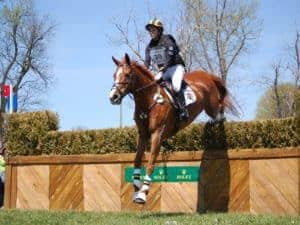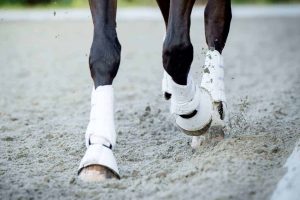Conditioning Arthritic Horses: Do’s and Don’ts

8 considerations when your performance horse starts showing signs of wear
Let’s start with the good news: In general, horses are living longer and staying active later in their lives than ever. This means we have more quality time with and rides on our beloved equine partners.
The bad news? As horses—particularly sport horses—age, they begin to suffer from related health issues. One of the most common is osteoarthritis (OA), which can make those rides uncomfortable for horses.
But there’s more good news: We can take steps to help keep horses moving and even competing as long (and as comfortably) as possible.
We asked two authorities on older horse care for their tips on conditioning horses with osteoarthritis. Nicola Jarvis, BVetMed, Cert. AVP (Equine Medicine, Equine Surgery Soft Tissue), MRCVS, a senior veterinary surgeon at Redwings Horse Sanctuary, in Hapton, Norfolk, U.K., and Karyn Malinowski, MS, PhD, professor and founding director at the Rutgers Equine Science Center, in New Brunswick, New Jersey, offer exercise, management, and veterinary intervention recommendations to help these horses perform to the best of their abilities.
Do: Know Your Foe
It’s just OA, right? That common creaky, achy condition we ourselves get in our knees, backs, and other joints over time. Sure, but it’s important to understand some of its complexities and why it can be so challenging to manage in horses.
“Osteoarthritis is a slowly progressive disease process within the horse’s joint, which leads to damage of the articular cartilage (within) the joint, the bone beneath the cartilage, and local soft tissue structures,” Jarvis says. “There are many initiating factors that could lead to OA in later life, such as general ‘wear and tear’ over the years, uneven weightloading through the joint due to poor conformation or hoof care, or a traumatic incident.”
Unfortunately, there’s currently no cure for arthritis—veterinarians can’t completely stop or reverse the condition’s effects. So owners of arthritic horses and their veterinarians are left to simply manage the pain caused by the condition, and that’s the biggest challenge, Malinowski says.
“Every horse will perceive the pain level differently,” she says. “Some will exercise right through it, while others will not.”
Finding and implementing appropriate treatments with a veterinarian’s help is key, and we’ll cover that in a moment. But there’s something else that’s important to remember about OA.
“We know that horses with arthritic joints do benefit from movement and regular exercise,” Malinowski says. Therefore, “horse owners should exercise these horses as long as the animal is able to do so without obvious discomfort.”

Don’t: Assume it’s Only Arthritis
“The prevalence of OA is thought to be greater than 50% in horses older than 15 years,” Jarvis says, so there’s a good chance you’ll deal with it at some stage.
Classic OA signs include heat, swelling due to excess joint fluid, lameness/pain, stiffness, deformation caused by bony changes, and crepitus—that popping, grinding, and crackling sound and sensation in an affected joint.
“For early OA, the older horse may appear to stiffen up if stabled overnight but then seem sound later in the day or (might act) ‘cheeky’ for the farrier when they are normally well-behaved, indicating they feel discomfort when flexing a limb or being asked to weight-bear just on one limb,” Jarvis says.
But, of course, these clinical signs can also point to other musculoskeletal issues—from soft tissue injury to fracture—some of which have very different treatment and management protocols than OA.
Consequently, “diagnosing why the horse might be sore or lame is always the best answer,” Malinowski says.
Have your veterinarian conduct a thorough lameness exam when you start to notice changes in soundness to ensure you’re dealing with OA and not a more acute condition that requires a different treatment approach.
Do: Embrace Exercise, but Plan Workouts Carefully
It might seem counterintuitive but, indeed, keeping an arthritic horse moving and exercising is in most cases preferable to letting him turn into a pasture puff.
“Maintaining muscle mass around the affected joint helps to stabilize (it), preventing joint laxity (looseness) and abnormal loading,” Jarvis says, which can lead to additional soundness issues.
However, it’s important to exercise the arthritic horse in scenarios that will promote longevity, rather than place him at undue risk for more joint pain, based on the severity of his disease.
“It is important that the exercise is tailored to the individual horse after consulting your vet,” Jarvis says. “Exercise can range from daily walks in hand to a gentle hack, but all should be accompanied by a warmup and cool-down.”
Malinowski agrees, suggesting a slow and lengthy (15- to 20-minute) warmup at the walk before progressing to the trot and canter. Give your horse walk breaks as needed, and encourage correct movement and balanced gaits. Also, be sure he is moving well and comfortably before beginning more complex tasks.
“The horse should be moving freely before moving on to higher level movements, like dressage or reining or jumping,” she adds.
Other considerations to remember:
- “For horses with OA, concussive road work is unhelpful, regardless of whether they are shod or unshod,” Jarvis says. Rather, confine most exercise to the softer footing typically found in grassy fields or well-maintained arenas. Also, avoid slick footing, which places horses at risk of slipping or falling.
- For some arthritic horses it might be necessary to limit exercise to flatter surfaces, because hills can place significant stress on joints, she adds.
- Sharp turns and sudden starts and stops can be jarring for horses with OA, Jarvis says, so be gradual in your requests during work.
- Consider alternative exercises as needed, Malinowski says. For instance, “swimming is great! The horse gets to move without the concussion of landing on a limb which may be arthritic.”
- Finally, keep realistic expectations about exercise levels, and remember that OA will progress over time. “An arthritic horse may get to the point that it can no longer perform higher-level movements or jumping without discomfort,” Malinowski says.
Adds Jarvis, “Once OA is more advanced, simply pottering about in a level, (even-footed) paddock is helpful for the aged horse.”
Dr. Nicola Jarvis
Do: Work With Your Veterinarian to Provide Appropriate Support
Not surprisingly, the treatment that’s best-suited for a particular horse depends on a number of factors, Jarvis says.
“The options will vary dependent on how many joints are affected by OA, the severity of the condition, concurrent conditions, and, of course, budgetary restrictions,” she says.
“Intra-articular medications (such as corticosteroids or hyaluronic acid), either to support the joint or to directly reduce inflammation, can be useful if only one or two joints are affected by OA or to treat a horse during a flare-up,” she adds.
If the arthritis is more widespread, however, veterinarians often recommend a systemic oral non-steroidal anti-inflammatory medication (NSAID), such as phenylbutazone (Bute) or firocoxib (Equioxx). How frequently you should administer medications and at what dose depends on the horse; your veterinarian will review administration instructions with you when he or she prescribes the medication. Don’t change the dose or frequency without checking with your vet.
A word of caution: Remember that the chronic use of NSAIDs can result in gastric ulcers, Malinowski says.
If your veterinarian recommends an NSAID, ask if he or she also recommends a gastric support product to help reduce the drug’s effects on the stomach lining.
Another option, of course, is an oral joint supplement. While manufacturers haven’t always had research to back up their product claims, more are having independent clinical studies conducted on their supplements. Ask your veterinarian if he or she has a supplement recommendation, and look for products backed by research if you opt to try one.
Don’t: Forget About Ice
Researchers are constantly learning new things about horses and their care and management. Some of these findings, of course, dispute what we’ve done for decades (rotational deworming, for example), while others confirm these age-old techniques have a place in modern-day horse care.
One of those latter concepts is ice.
“Ice is always a universal helper to reduce inflammation, whether it be muscular or skeletal,” Malinowski says.
Ask your veterinarian whether your horse might benefit from icing (either in an ice/water slurry or via commercial ice boots) after exercise.
Don’t: Overlook Hoof Care
Proper hoof care is key to helping arthritic horses stay sound and comfortable in work.
“It is essential that the feet are well-balanced to ensure even weight-loading through the joints,” Jarvis says. “Long toes and collapsed heels also put unnecessary strain on the joints, ligaments, and tendons, so regular trims are required and can ease breakover (how the horse’s heel lifts off the ground and rotates over the toe during movement),” promoting soundness in the long run.
Your veterinarian and farrier might even recommend special shoeing to reduce impact on your horse’s joints.
Do: Keep Your Horse at a Healthy Weight
What does nutrition have to do with OA? A lot.
“An overweight horse will struggle with excessive loading through the joints, and obesity is frequently linked with many inflammatory and degenerative diseases such as OA in humans and other species,” including horses, Jarvis says.
Especially if your horse is still performing more technical or strenuous work, aim to keep him at an appropriate weight and body condition (ideally, 4 to 6 on the 1-to-9 Henneke scoring scale) to avoid stressing his joints excessively and keep him exercising for as long as possible.
Don’t:Work Your Horse During Flare-Ups
The caveat to “keep your horse moving” is when he has a flare-up, Jarvis says.
Horses with affected joints might suffer a flare-up “after playing out at pasture or slipping, leading to a swollen joint and obvious lameness,” she says. “These flare-ups should be treated promptly, as the inflammation ultimately causes further damage to the joint.”
Joint injections and/or anti-inflammatory medications are potential treatments for flare-ups; always work with your veterinarian to treat them.
Take-Home Message
A horse’s ridden or even competitive career doesn’t have to end just because of an OA diagnosis. It might just take a little more care and planning to keep him healthy, happy, and comfortable.
Get a definitive diagnosis, work with your veterinarian to provide appropriate support, plan workouts carefully, and implement management techniques to support healthy joints.
And above all, says Malinowski, “keep the horse moving on a daily basis.”

Related Articles
Stay on top of the most recent Horse Health news with

















